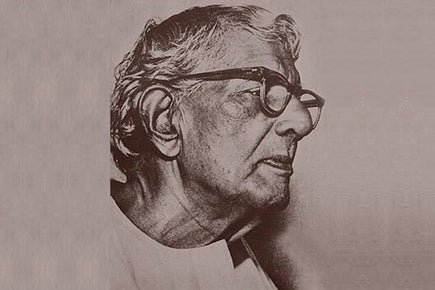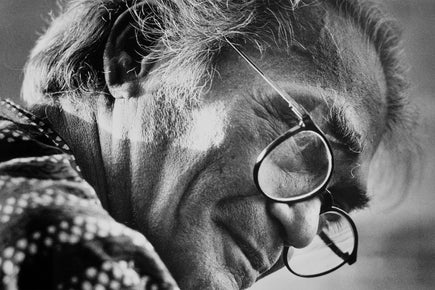Vincent van Gogh: One of the Greatest Artists, But A Life of Despair and Desolation
One of the most influential artists in history, Vincent van Gogh left behind a mammoth collection of works, in which he elevated scenes from mundane everyday life with rich, poetic strokes. Often reflecting on his own life through his art, the great artist helped lay the foundations of modern art. Posthumously celebrated as one of the greatest artists of all time, van Gogh’s life, with its looming cloud of mental distress and gloom, along with his prodigious talent, made the post-impressionist master the perfect fit for the tag of the quintessential “tortured artist.”
 Vincent van Gogh (Source: Van Gogh Museum/Wikimedia Commons)
Vincent van Gogh (Source: Van Gogh Museum/Wikimedia Commons)
A Withdrawn Childhood Close to Nature
Vincent van Gogh – in full Vincent Willem van Gogh – was born on March 30, 1853, in Zundert, Netherlands. Born to Theodorus van Gogh, an austere Protestant pastor and Anna Cornelia Carbentus, an artist whose love of nature and art van Gogh inherited, the young artist was quiet and self-contained, and spent his free time wandering the countryside, observing nature. At the age of 15, due to a financial crisis in his family, van Gogh was forced to leave school and start working. Working as an art dealer in London from 1873 to 1875 and in Paris from then until 1876, van Gogh frequented art galleries and developed his own distinct artistic sensibility. He also loved English literature and developed a strong liking for the writings of Charles Dickens and George Eliot.
A Deeply Spiritual, Hopeless Romantic
In London, van Gogh fell in love with his landlady’s daughter, Eugenie Loyer. Suffering from a breakdown after she rejected his marriage proposal, van Gogh dismissed art and literature, and devoted his life to the church. He taught at a school and later moved to an impoverished coal mine in the south of Belgium, where he preached to the sick and poor. In an act of selflessness, van Gogh decided to live in a tiny hut there – an act the evangelical community did not approve of, resulting in his dismissal from missionary practice.
 Garden with Courting Couples: Square Saint Pierre, 1887 (Source: Van Gogh Museum/Wikimedia Commons)
Garden with Courting Couples: Square Saint Pierre, 1887 (Source: Van Gogh Museum/Wikimedia Commons)
Sinking into despair with the belief that his faith was destroyed, in the fall of 1880, van Gogh decided to move to Brussels and become an artist. This was when he started taking art seriously and believed that he would bring consolation to humanity through art. van Gogh wrote in one of his letters: “I want to give the wretched a brotherly message. When I sign [my paintings] ‘Vincent,’ it is as one of them.”
Van Gogh’s inability to maintain happy relationships with women, perhaps owing to his unstable temperament, caused him great sorrow and pain. The artist, who said “I can’t live without love,” was an astute romantic who believed that love was infinite, deep and real. His numerous failed attempts at romantic relationships include his cousin Kee Vos-Stricker, a prostitute named Sien and a restaurant owner in Paris, Agostina Segatori. These women often made it into van Gogh’s artworks, much like almost all other aspects of his life which took form in his art.
 In the cafe: Agostina Segatori in Le Tambourin, 1887 (Source: Van Gogh Museum/Wikimedia Commons)
In the cafe: Agostina Segatori in Le Tambourin, 1887 (Source: Van Gogh Museum/Wikimedia Commons)
Letters of Musings and a Strong Brotherly Bond
Vincent van Gogh eventually found true, requited love in nature, art and his brother, Theo van Gogh – an art dealer in Paris, who supported him all through his pursuit of art. In van Gogh’s famous, heartfelt letters to his brother, he goes into great detail about his life. Signed “Loving Vincent,” these letters were not just exchanging of life events, but went into meditations on love and the meaning and purpose of life itself.
 Van Gogh's letter to Theo, along with a sketch, dated 1881 (Source: vangoghmuseum.nl/Vincent van Gogh Foundation)
Van Gogh's letter to Theo, along with a sketch, dated 1881 (Source: vangoghmuseum.nl/Vincent van Gogh Foundation)
Theo introduced van Gogh to artists in Paris, and ensured that his brother did not run out of money, even after the rest of his family had abandoned him. It was in the French capital that van Gogh first saw impressionist art, and he was drawn to the luminous shades which were used in those paintings. He also met modern art masters like Henri de Toulouse-Lautrec and Paul Gauguin here, and Theo introduced him to Impressionist painters like Camille Pissarro and Georges Seurat.
A Decade of Art
Vincent van Gogh’s artistic career was extremely short, lasting only 10 years from 1880 to 1890. He studied drawing at the Brussels Academy and moved in with his parents for a short period in 1881, where he worked hard and self-trained. Realising the need for guidance from artists who had more experience, he started working with Anton Mauve, a Dutch landscape painter. He experimented with oil paints, shortly after, and moved to Drenthe, an isolated part of the northern Netherlands, to work “alone with nature.”
In the years that followed, van Gogh’s art grew bolder, and he created artworks featuring his signature subjects – still life, landscapes and figures. His famous works like Weavers and The Potato Eaters were done during this period, and allude to the daily life of peasants and the countryside.
 The Potato Eaters, 1885 (Source: vangoghgallery.com)
The Potato Eaters, 1885 (Source: vangoghgallery.com)
Arriving in Arles in southern France in 1888, the artist finally had his breakthrough in art. In the period between 1886 and 1888, van Gogh’s post-impressionistic style had taken complete shape and there was a shift from the dull tones of his previous works to pure colours and a distinct brushwork similar to the pointillistic style. Masterpieces such as the Portrait of Père Tanguy and Self-Portrait in Front of the Easel were born, and van Gogh finally painted in full swing.
 Portrait of Pere Tanguy, 1887 (Source: Musée Rodin/Wikimedia Commons)
Portrait of Pere Tanguy, 1887 (Source: Musée Rodin/Wikimedia Commons)
The time that van Gogh spent in Arles was his most productive – he fell in love with the bright southern sun and painted in ecstatic outbursts of creativity. He painted olive trees, sunflowers, wheat fields and cafes, in some of his most iconic works. Van Gogh was joined by his acquaintance and French artist, Paul Gauguin at his Yellow House in Arles, and the two worked together, though with disastrous results, owing to van Gogh’s unstable temperament. Suffering from declining physical and mental health and completely financially dependent on Theo by now, the artist spent all his money on paints and barely ate. Towards the end of 1888, van Gogh and Gauguin had a fallout, and a physically and emotionally exhausted van Gogh charged at Gauguin with a razor, ultimately cutting off the lower half of his own left ear. Gauguin then left for Paris and van Gogh had to be in medical care.
 Sunflowers, 1889 (Source: vangoghmuseum.nl)
Sunflowers, 1889 (Source: vangoghmuseum.nl)
An Untimely End Marked by Despair
Spending the next 12 months of his life in an asylum at Saint-Rémy-de-Provence, van Gogh was haunted by recurrent attacks of despair. He worked from his memory, due to the limited choice of subjects in the asylum, and his works from the period are marked by a certain sadness and calm – the vivid, sun-drenched colours of Arles were muted now, and there were dynamic, bold forms and vigorous lines. Paintings including The Starry Night, Garden of the Asylum, Olive Trees, Les Alpilles, Cypresses, portraits of doctors, and interpretations of paintings by Rembrandt, Delacroix, and Millet date from this period.
 The Starry Night, 1889 (Source: Museum of Modern Art/britannica.com)
The Starry Night, 1889 (Source: Museum of Modern Art/britannica.com)
Homesick and longing to see his brother, van Gogh arrived in Paris in May 1890. Shortly after, he went to stay with a homeopathic doctor-artist, Paul-Ferdinand Gachet, in the village of Auvers-sur-Oise. The countryside inspired van Gogh to work enthusiastically for a short phase, and he painted cornfields, cottages, the river valley and the church. But soon after, still wallowing in despair and loneliness, van Gogh shot himself for reasons that remain unknown and on July 29, 1890, aged 37, the great artist passed away.
 Self Portrait, 1889 (Source: vincentvangogh.org)
Self Portrait, 1889 (Source: vincentvangogh.org)
Celebrated as the Quintessential Tortured Hero
Van Gogh was posthumously celebrated for his deeply evocative artworks, and considered one of the greatest Dutch artists of all time, largely based on the works of the last three years of his life. Though he sold only one artwork in his entire lifetime and was virtually unknown until his death, his works have had a powerful influence on the development of modern painting. After van Gogh's death, memorial exhibitions were held in Brussels, Paris, The Hague and Antwerp. His reputation started growing from the early years of the 20th century and his image as the struggling, tortured artist became a huge part of the dramatic narrative spun around his life. The letters van Gogh wrote to Theo (more than 650 of them!) were published in three volumes in 1914, further fuelling the myths around his life. These letters, hailed as fine pieces of literature, heightened van Gogh’s worldwide fame.
Since clear historical records of van Gogh’s works didn’t exist, there are many uncertainties that have remained with respect to the art he created. For instance, his 1890 painting Wheatfield with Crows - one of his greatest works - is widely misconceived as his last painting and an expression of agony. But in reality, it was not his last work; it was just completed in the last few weeks of his life.
 Wheatfield with Crows, 1890 (Source: vincentvangogh.org)
Wheatfield with Crows, 1890 (Source: vincentvangogh.org)
Today, van Gogh's works are among the world's most expensive paintings – Portrait of Dr Gachet, Portrait of Joseph Roulin and Irises sold for over US$100 million each, and in 2015, L'Allée des Alyscamps sold for US$66.3 million at Sotheby's, New York.
 L'Allée des Alyscamps, 1888 (Source: vangogh.com)
L'Allée des Alyscamps, 1888 (Source: vangogh.com)
Van Gogh had an exceptional way of using luminous colours and fiery strokes to express his emotions and thoughts, using simple objects like in Plate of Onions (1889) and Tree Roots (1890) or a nightmarish café scene like in The Night Café (1888). But his art cannot be reduced to just an expression of his mental state, which is often the case, and needs to be interpreted removed from these melodramatic views. Van Gogh’s troubled life may have shaped a chunk of his artworks, but he rises above the popular mystical image of an artist driven mad by his art, through his diverse and highly stylised body of work. The legendary artist’s deeply emotive art transcends time and space, leaving his admirers all over the world in awe even today, with its surreal, dreamlike quality.
























































































